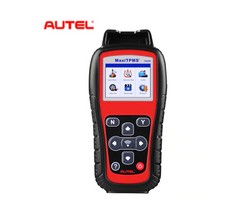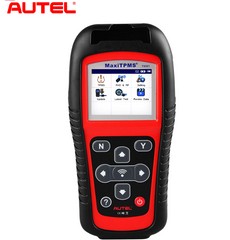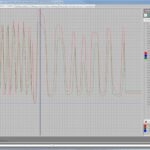Are you looking for the best TPMS (Tire Pressure Monitoring System) tool? Autel Maxitpms Ts501 Vs TS508 are two popular options. This in-depth comparison explores the key differences, advantages, and disadvantages of each tool to help you make the right choice. At CARDIAGTECH.NET, we provide the tools you need to keep vehicles running smoothly. Discover comprehensive TPMS solutions and professional guidance to enhance your automotive repair capabilities.
1. Autel TS501 Vs TS508: A Detailed Comparison
Let’s dive into the specifics with a comparison chart highlighting the features of the Autel TS501 and TS508.
| Feature | Autel MaxiTPMS TS508 | Autel MaxiTPMS TS501 |
|---|---|---|
| Customer Rating | 4.5 Stars | 3.5 Stars |
| Price (Approximate) | $235.00 at CARDIAGTECH.NET | $198.00 at CARDIAGTECH.NET |
| Battery | 3.7V Li-polymer, 3200 mAh | 3.7V Li-polymer, 2400 mAh |
| Quick Mode & Advance Mode | Yes | No |
| Activate TPMS Sensors | Yes | Yes |
| Read Sensor Data | Yes | Yes |
| TPMS Diagnostics (Complete Health Check) | Yes | Yes |
| Read/Clear TPMS DTCs | Yes | Yes |
| Scan & Copy Sensor ID | Yes | Yes |
| Manual OE ID Input | Yes | Yes |
| Program MX-Sensor (Auto ID Creation) | Yes | Yes |
| Read Sensor ID by OBD | Yes | Yes |
| Relearn by OBD | Yes | Yes |
| Relearn Procedure Guide | Yes | Yes |
| Check Key Fob | Yes | Yes |
| Tire Type/Pressure Selection | Yes | No |
| Built-in Rechargeable Battery | Yes | Yes |
| Protective Housing | Yes | Yes |
| Print TPMS Data via PC | Yes | Yes |
| Internet Update | USB | SD Card |
| Multilingual Support | Yes | Yes |
| Historical Test Records | Yes | Yes |
| Software Updates | Free | Free |
| Warranty | 1 Year Limited | 1 Year Limited |



2. Key Differences: Autel TS501 vs TS508
While both tools share core TPMS functionalities, some key distinctions set them apart. These differences in battery capacity, function, and update methods can significantly impact your user experience.
2.1 Battery Capacity
The Autel TS508 boasts a 3200 mAh battery, compared to the TS501’s 2400 mAh battery. This larger capacity translates to longer operational time for the TS508, reducing the need for frequent recharges.
2.2 Functional Capabilities
The TS508 offers “Quick Mode” and “Advanced Mode,” streamlining TPMS tasks. Quick Mode provides basic functions for rapid sensor checks, while Advanced Mode offers comprehensive diagnostics. The TS501 lacks this dual-mode feature. Furthermore, the TS508 includes tire type and pressure selection, enhancing its versatility.
2.3 Update Method
The TS508 uses a USB connection for updates, while the TS501 relies on an SD card. USB updates are generally faster and more convenient, while SD cards might require additional hardware for connectivity.
3. Autel MaxiTPMS TS508: A Comprehensive Overview
The Autel MaxiTPMS TS508 is designed for comprehensive TPMS management, activating sensors, reading sensor data, checking system health, programming MX-sensors, and performing relearning procedures. Its dual-mode operation ensures efficient workflows.
3.1 Two TPMS Service Modes
The TS508 offers Quick and Advanced modes, catering to different service needs.
-
Quick Mode: Streamlines basic TPMS functions, such as sensor checks and MX-sensor programming.
-
Advanced Mode: Provides complete TPMS functions, including sensor checks, diagnostics, MX-sensor programming, and relearning.
This flexibility lets technicians optimize their approach based on the task at hand, saving time and improving efficiency.
3.2 Dedicated TPMS Status Screen
The dedicated screen allows users to:
- Read ECU sensor IDs.
- Check sensor and ECU ID matching.
- Read and clear DTCs with descriptions.
- Program MX-sensors with four options: Activate replication, Manual input, Auto creation, and OBD copy.
3.3 Pros and Cons of Autel MaxiTPMS TS508
| Pros | Cons |
|---|---|
| Complete Functionality | Customized Battery |
| Easy to Carry | Compatibility List Needed |
| Long Battery Life | |
| Simple Operation | |
| Free Lifetime Updates |
4. Autel MaxiTPMS TS501: A Detailed Look
The Autel MaxiTPMS TS501 offers wireless TPMS diagnostics and reset capabilities, designed to diagnose TPMS issues, activate OEM/universal sensors, clone IDs, reprogram sensors to the vehicle’s ECU, and turn off warning lights.
4.1 Overview of TPMS Status
The single-screen layout allows easy access to sensor data, clarifying TPMS function status, comparing sensor and ECU data, and identifying system faults. It also highlights sensors with low battery levels.
4.2 User-Friendly Software
The TS501 simplifies operation with clear instructions and code definitions. Free software updates enhance diagnostics and expand vehicle coverage.
4.3 TPMS Diagnostics with OBDII
The TS501 connects via OBDII, offering relearning programs and various programming options like sensor ID cloning, auto ID creation, and manual ID input, eliminating the need for sensor relearning.
4.4 Pros and Cons of Autel MaxiTPMS TS501
| Pros | Cons |
|---|---|
| Easy to Use | Autel Sensors Only |
| OBD2 Connection Support | Customized Battery |
| Affordable Price | Compatibility List Needed |
5. Comparative Analysis: Choosing the Right Tool
Both the MaxiTPMS TS501 and TS508 offer excellent value. However, the TS508’s Quick Mode, longer battery life, and comprehensive functions give it a slight edge, particularly for professional mechanics. The TS501 remains a cost-effective choice for users seeking essential TPMS functions.
6. How TPMS Tools Enhance Automotive Repair Efficiency
TPMS tools, like the Autel TS501 and TS508, are indispensable for modern automotive repair. They offer features and benefits that address common challenges faced by technicians and shop owners.
6.1 Addressing Customer Challenges
Challenge: The physical demands and exposure to chemicals in automotive repair can be taxing.
Solution with TPMS Tools: TPMS tools streamline the diagnostic process, reducing physical strain and exposure time.
Challenge: Keeping up with evolving automotive technology.
Solution with TPMS Tools: These tools receive regular software updates, ensuring compatibility with the latest vehicle models and TPMS technologies.
Challenge: Time constraints and pressure to complete jobs quickly.
Solution with TPMS Tools: Features like Quick Mode on the TS508 enable faster sensor checks and programming, reducing turnaround time.
Challenge: Competition from other repair shops.
Solution with TPMS Tools: Offering TPMS services with advanced tools enhances service quality and attracts customers seeking specialized care.
Challenge: Difficulty finding quality tools that meet specific needs.
Solution with CARDIAGTECH.NET: CARDIAGTECH.NET offers a curated selection of reliable TPMS tools and expert advice to help customers find the perfect fit.
6.2 Services Provided by TPMS Tools
Service: Enhancing workflow efficiency.
Benefit: TPMS tools automate sensor activation, ID cloning, and relearning, significantly reducing manual effort.
Service: Ensuring accuracy and safety.
Benefit: Accurate sensor readings and diagnostic capabilities minimize errors and ensure correct tire pressure, enhancing vehicle safety.
Service: Cost-effective maintenance.
Benefit: Proper tire pressure reduces wear and improves fuel efficiency, saving customers money.
Service: Increasing revenue and trust.
Benefit: Offering comprehensive TPMS services adds value and builds customer loyalty.
Service: Elevating garage reputation.
Benefit: Using advanced tools demonstrates a commitment to quality and expertise, enhancing the garage’s image.
7. Maximizing Investment in Automotive Repair Tools
Investing in the right tools is crucial for success in the automotive repair industry. Here’s how to make the most of your investment in TPMS tools and other diagnostic equipment:
7.1 Key Considerations Before Purchase
Needs Assessment: Understand your specific service requirements, considering the types of vehicles you service and the TPMS functionalities you need.
Budget Allocation: Set a realistic budget that balances initial cost with long-term value, considering features like software updates and warranty.
Research and Reviews: Read reviews, compare models, and consult with other professionals to get insights on performance and reliability.
Brand Reputation: Choose reputable brands like Autel, known for quality and innovation in automotive diagnostic tools.
7.2 Selecting the Right TPMS Tool
Functionality: Ensure the tool supports the TPMS functions you need, such as sensor activation, ID cloning, and relearning procedures.
Compatibility: Verify that the tool is compatible with the makes and models of vehicles you service.
Ease of Use: Look for an intuitive interface and clear instructions to minimize training time and maximize efficiency.
Update and Support: Check for regular software updates and reliable technical support to keep your tool current and functional.
7.3 Additional Must-Have Automotive Repair Tools
OBDII Scanners: Essential for diagnosing engine and system issues, reading error codes, and monitoring performance data.
Multimeters: Crucial for electrical diagnostics, measuring voltage, current, and resistance.
Battery Testers: Evaluate battery health and diagnose charging system problems.
Brake Lathes: Refinish brake rotors and drums for optimal braking performance.
Alignment Machines: Ensure proper wheel alignment for even tire wear and improved handling.
Lifts and Jacks: Essential for safely raising vehicles for undercarriage repairs.
Air Compressors: Power pneumatic tools like impact wrenches, spray guns, and sanders.
7.4 Optimizing Tool Usage and Maintenance
Training: Provide training for technicians to effectively use the tools and understand their capabilities.
Maintenance: Follow manufacturer guidelines for cleaning, calibration, and storage to prolong tool life.
Software Updates: Regularly update software to access new features, vehicle coverage, and bug fixes.
Calibration: Calibrate tools regularly to ensure accuracy and reliable readings.
Storage: Store tools in a clean, dry environment to prevent damage and corrosion.
By carefully considering these factors and adopting best practices for tool usage and maintenance, you can maximize your investment in automotive repair tools and provide superior service to your customers.
8. Why Choose CARDIAGTECH.NET for Your Automotive Tool Needs?
At CARDIAGTECH.NET, we understand the challenges you face in the automotive repair industry. That’s why we offer a wide range of high-quality diagnostic tools and equipment to help you succeed.
8.1 Overcoming Customer Pain Points
Difficulty Finding Quality Tools: We offer a curated selection of reliable tools from trusted brands like Autel, ensuring you get top-notch performance.
Keeping Up with Technology: Our tools come with regular software updates, so you’re always equipped to handle the latest vehicle models and technologies.
Time Constraints: We offer tools like the Autel TS508 with Quick Mode to help you streamline your workflow and get jobs done faster.
Competition: Our advanced diagnostic tools enable you to offer specialized services, setting you apart from the competition.
High Costs: We offer competitive pricing and financing options to make quality tools accessible to businesses of all sizes.
8.2 Benefits of Choosing CARDIAGTECH.NET
Wide Selection: We offer a comprehensive range of diagnostic tools, TPMS tools, OBDII scanners, and more.
Expert Advice: Our knowledgeable team can help you choose the right tools for your specific needs and provide technical support.
Quality Assurance: We only offer tools from reputable brands known for their durability and performance.
Customer Support: We provide excellent customer service, ensuring you have the support you need to get the most out of your tools.
Competitive Pricing: We offer competitive prices and financing options to help you stay within budget.
8.3 Success Stories
Many of our customers have transformed their automotive repair businesses with our tools and support. Here are a few examples:
Increased Efficiency: A local repair shop reduced their diagnostic time by 50% with our advanced OBDII scanner.
Improved Accuracy: A tire shop improved their TPMS service accuracy with the Autel TS508, leading to higher customer satisfaction.
Expanded Services: A small garage expanded their services to include advanced diagnostics, attracting new customers and increasing revenue.
8.4 Testimonials
- “CARDIAGTECH.NET has been a game-changer for my business. Their tools are reliable, and their support is outstanding.” – John S., Auto Repair Shop Owner
- “I was struggling to keep up with the latest TPMS technology until I found CARDIAGTECH.NET. Their Autel TS508 has made my job so much easier.” – Maria L., Tire Technician
- “CARDIAGTECH.NET helped me choose the perfect diagnostic tools for my new garage. Their advice was invaluable.” – David K., Garage Owner
9. Ready to Enhance Your Automotive Repair Capabilities?
Don’t let outdated tools hold you back. Contact CARDIAGTECH.NET today to discover how our advanced diagnostic tools can revolutionize your business.
- Address: 276 Reock St, City of Orange, NJ 07050, United States
- WhatsApp: +1 (641) 206-8880
- Website: CARDIAGTECH.NET
Let us help you overcome the challenges you face and achieve success in the automotive repair industry. Contact us now for expert advice and start transforming your business today!
10. FAQ: Addressing Common Questions About TPMS Tools
Here are some frequently asked questions to help you understand more about TPMS tools and their functionality.
10.1 How to Distinguish Between Indirect TPMS and Direct TPMS?
Direct TPMS uses tire pressure sensors on each wheel, while indirect TPMS uses ABS speed sensors to calculate pressure.
10.2 How to Ensure That the Vehicle Has a Direct TPMS Sensor?
Use your Autel tool to select the vehicle’s make, model, and year. The tool will indicate whether the vehicle has an indirect (sensor-free) or direct TPMS. Direct TPMS sensors have rubber or metal stems.
10.3 What Does it Mean to Relearn TPMS Sensors? When is Relearning Needed?
Each TPMS sensor has a unique ID registered in the vehicle’s TPMS module. Relearning registers new sensor IDs after sensor replacement or tire rotation.
10.4 How to Relearn TPMS Sensors?
Three methods exist:
- Auto Relearn: Drive the vehicle at a specific speed for a set time.
- OBD Relearn: Connect the TPMS tool to the vehicle’s OBD port to write the sensor ID into the ECU.
- Stationary Relearn: Relearn the sensor ID without driving or writing to the TPMS module.
10.5 Can I Program Other Brands (Dorman or Schrader) or Only Autel MX Sensors?
You can program original OEM TPMS and Autel MX sensors.
10.6 How Often Should I Update My TPMS Tool’s Software?
It is recommended to update your TPMS tool’s software regularly, ideally every few months, to ensure compatibility with the latest vehicle models and to access new features and improvements.
10.7 What is the Typical Battery Life of a TPMS Sensor?
The typical battery life of a TPMS sensor is between 5 to 10 years, depending on usage and environmental conditions.
10.8 What is the Difference Between Sensor Activation and Sensor Programming?
Sensor activation is the process of waking up the sensor to read its data, while sensor programming involves writing new data to the sensor, such as a new ID.
10.9 Can a TPMS Tool Help Diagnose Other Vehicle Issues?
While TPMS tools are primarily designed for tire pressure monitoring systems, some advanced models may offer additional diagnostic capabilities, such as reading and clearing diagnostic trouble codes (DTCs) for other vehicle systems.
10.10 What are the Benefits of Using Autel MX Sensors Compared to Other Brands?
Autel MX sensors are known for their broad vehicle coverage, ease of programming, and reliability, making them a popular choice among automotive professionals.
By providing these detailed answers, we hope to clarify any uncertainties and empower you to make informed decisions about your TPMS tool investments.

